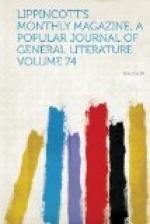There were several reasons which rendered such an examination historically interesting and curious. A certain degree of doubt has been cast—mainly by Grimm—on the question whether the tomb be in fact that of Lorenzo, the father of Catherine de’ Medici, the celebrated queen of France—whether it be not rather that of Giuliano, his uncle. For my part, I had always thought that there was little or no foundation for the doubt. The main features of the story of Alexander will probably be in the memory of the reader. The Florentine republic and liberty were destroyed in 1527 by the united forces of the traitor pope, the Medicean Clement VII., and Charles V., with the understanding that this Alexander should marry Margaret, the emperor’s illegitimate daughter, and that Florence should become a dukedom to dower the young couple withal. Who and what this Alexander was has always been one of the puzzles of history. He was, tradition says, very swarthy, and was generally believed to be the son of a Moorish slave-mother. He was certainly illegitimate; and the question, Who was his father? was always a doubtful one, though he has generally been called the son of Lorenzo. I have elsewhere given at length reasons for believing rather that whispered bit of scandal of the time which declared the pope, Clement VII., to be his father. When Florence fell he became duke, and reigned over the unhappy city for seven years, in such sort that the murder of him in 1537 by his kinsman Lorenzino, traitorously and cowardly done as the deed was, was deemed the act of a patriot. The story of such a deed, done at midnight in a private chamber, and never made the subject of legal investigation, of course reaches subsequent generations enveloped in more or less of uncertainty. Now, it was likely enough that the careful examination of the remains in the tomb in question might throw light on sundry points of Alexander’s story.
In the first place, the identity of the tomb is now fixed beyond the possibility of a doubt. It was known that the body of the murdered Alexander was placed in the tomb of his putative father, Lorenzo. If, therefore, the body of Alexander should be found in this sepulchre, the tomb is proved to have been that of Lorenzo. When the lid of the sarcophagus was raised, there accordingly were the two bodies visible—one dressed in white, the other in black. It has been assumed—and I think the assumption is abundantly justified, as will presently be seen—that the skeleton in black is that of Lorenzo, and the skeleton in white that of Alexander. The relative position of the bodies was very singular. The heads were at opposite ends of the sarcophagus, and the bodies were placed, not side by side, but each between the legs of the other. One of the bodies, that of Lorenzo, seemed when the lid of the sarcophagus was raised to be headless, but on examination the skull was found under the breast of the black tunic that covered the body. There




